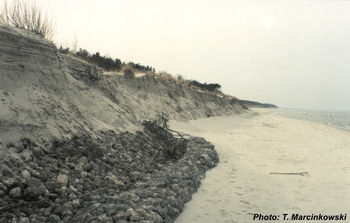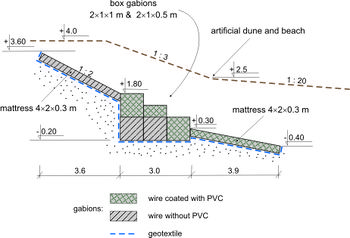Difference between revisions of "Light revetments built-in into artificial dunes"
(→Prevention of dune erosion) |
Dronkers J (talk | contribs) |
||
| (10 intermediate revisions by 3 users not shown) | |||
| Line 1: | Line 1: | ||
| − | This article presents a light, 'built-in' [[revetment]], which can supplement | + | This article presents a light, 'built-in' [[revetment]], which can supplement soft shoreline protection solutions, like [[shore nourishment|shore nourishments]]. The article considers the construction of built-in structures in artificial dunes and presents experiences from Poland. |
==Erosion and soft shoreline protection== | ==Erosion and soft shoreline protection== | ||
On the Polish coast, there are numerous places which are subject to more or less serious [[erosion]]. The maritime and coastal economy, including the coastal management and protection, is ruled by the Maritime Offices – governmental institutions subordinate to the Ministry of Maritime Economy. Each of the Maritime Offices (in Gdynia, Słupsk and Szczecin) has the Inspectorate of Coastal Protection, responsible for defence measures undertaken at individual shore segments. | On the Polish coast, there are numerous places which are subject to more or less serious [[erosion]]. The maritime and coastal economy, including the coastal management and protection, is ruled by the Maritime Offices – governmental institutions subordinate to the Ministry of Maritime Economy. Each of the Maritime Offices (in Gdynia, Słupsk and Szczecin) has the Inspectorate of Coastal Protection, responsible for defence measures undertaken at individual shore segments. | ||
| − | According to the present state-of-the-art and current trends in coastal engineering, artificial beach nourishment and formation of artificial dunes is an optimal protective measure. This solution requires neither the concentration of large funds in short time nor the engagement of sophisticated equipment and technologies. Moreover, it is the best from the ecological point of view, because provides aesthetics of the venture and sustainable coexistence with natural coastal forms. Finally, artificial beach nourishment is recommended as the primary shore protection measure on strength of the Polish parliamentary “Law on the establishment of a multi-year coastal protection programme” (of 18th April 2003<ref>Act of Parliament of Republic of Poland (2003) on establishment of long term ‘Coastal Protection Program’ (see [[ | + | According to the present state-of-the-art and current trends in coastal engineering, [[#artificial nourishment|artificial beach nourishment]] and formation of artificial dunes is an optimal protective measure. This solution requires neither the concentration of large funds in short time nor the engagement of sophisticated equipment and technologies. Moreover, it is the best from the ecological point of view, because provides aesthetics of the venture and sustainable coexistence with natural coastal forms. Finally, artificial beach nourishment is recommended as the primary shore protection measure on strength of the Polish parliamentary “Law on the establishment of a multi-year coastal protection programme” (of 18th April 2003<ref>Act of Parliament of Republic of Poland (2003) on establishment of long term ‘Coastal Protection Program’ (see [[Policy in Poland]])</ref>). |
==Prevention of dune erosion== | ==Prevention of dune erosion== | ||
[[Image:Hel_1.jpg|350px|thumbnail|right|Figure 1 Gabion structure]] | [[Image:Hel_1.jpg|350px|thumbnail|right|Figure 1 Gabion structure]] | ||
| − | During heavy and long-lasting storms, the artificial beach and [[dune]] can be washed away. Therefore, at shore segments with valuable objects in the hinterland, it is recommended to supplement the above soft solutions by “invisible” structures, namely light revetments built-in into artificial dunes. These hidden [[revetment|revetments]] are assumed to constitute a kind of “second line of defence” during extreme storms, when the beach disappears and the dune can be breached. Most often, these additional [[revetment|revetments]] are built as "gabion" structures (see Figure 1 and 2). If the revetment is uncovered after a storm, the artificial beach and dune should be rebuilt. Possible damages of the revetments ought to be repaired before. See also the article [[revetments | + | During heavy and long-lasting storms, the artificial beach and [[dune]] can be washed away, see [[Dune erosion]]. Therefore, at shore segments with valuable objects in the hinterland, it is recommended to supplement the above soft solutions by “invisible” structures, namely light revetments built-in into artificial dunes. These hidden [[revetment|revetments]] are assumed to constitute a kind of “second line of defence” during extreme storms, when the beach disappears and the dune can be breached. Most often, these additional [[revetment|revetments]] are built as "[[gabions|gabion]]" structures (see Figure 1 and 2). If the revetment is uncovered after a storm, the artificial beach and dune should be rebuilt. Possible damages of the revetments ought to be repaired before. See also the article [[revetments]]. |
[[Image:Gabions.jpg|350px|thumbnail|right|Figure 2 Schematization of a gabion revetment built-in into artificial dune]] | [[Image:Gabions.jpg|350px|thumbnail|right|Figure 2 Schematization of a gabion revetment built-in into artificial dune]] | ||
| Line 15: | Line 15: | ||
==See also== | ==See also== | ||
| − | * [[ | + | * [[Stability of rubble mound breakwaters and shore revetments]] |
| + | * [[Dune erosion]] | ||
| + | * [[Dealing with coastal erosion]] | ||
| + | * [[Hard coastal protection structures]] | ||
* [[Shore nourishment]]: a soft shoreline protection measurement | * [[Shore nourishment]]: a soft shoreline protection measurement | ||
* Definition of [[revetment]] with links to other articles on revetments. | * Definition of [[revetment]] with links to other articles on revetments. | ||
| Line 27: | Line 30: | ||
|AuthorName= Rafal Ostrowski }} | |AuthorName= Rafal Ostrowski }} | ||
| − | + | [[Category:Coastal protection]] | |
| − | + | [[Category:Hard structures]] | |
| − | + | [[Category:Soft coastal interventions]] | |
| − | [[Category:Coastal | + | [[Category:Beaches]] |
| − | |||
| − | [[Category: | ||
| − | [[Category: | ||
| − | [[Category: | ||
| − | |||
| − | |||
| − | |||
| − | |||
Latest revision as of 12:45, 16 February 2024
This article presents a light, 'built-in' revetment, which can supplement soft shoreline protection solutions, like shore nourishments. The article considers the construction of built-in structures in artificial dunes and presents experiences from Poland.
Contents
Erosion and soft shoreline protection
On the Polish coast, there are numerous places which are subject to more or less serious erosion. The maritime and coastal economy, including the coastal management and protection, is ruled by the Maritime Offices – governmental institutions subordinate to the Ministry of Maritime Economy. Each of the Maritime Offices (in Gdynia, Słupsk and Szczecin) has the Inspectorate of Coastal Protection, responsible for defence measures undertaken at individual shore segments.
According to the present state-of-the-art and current trends in coastal engineering, artificial beach nourishment and formation of artificial dunes is an optimal protective measure. This solution requires neither the concentration of large funds in short time nor the engagement of sophisticated equipment and technologies. Moreover, it is the best from the ecological point of view, because provides aesthetics of the venture and sustainable coexistence with natural coastal forms. Finally, artificial beach nourishment is recommended as the primary shore protection measure on strength of the Polish parliamentary “Law on the establishment of a multi-year coastal protection programme” (of 18th April 2003[1]).
Prevention of dune erosion
During heavy and long-lasting storms, the artificial beach and dune can be washed away, see Dune erosion. Therefore, at shore segments with valuable objects in the hinterland, it is recommended to supplement the above soft solutions by “invisible” structures, namely light revetments built-in into artificial dunes. These hidden revetments are assumed to constitute a kind of “second line of defence” during extreme storms, when the beach disappears and the dune can be breached. Most often, these additional revetments are built as "gabion" structures (see Figure 1 and 2). If the revetment is uncovered after a storm, the artificial beach and dune should be rebuilt. Possible damages of the revetments ought to be repaired before. See also the article revetments.
Experiences from Poland
Experience has shown that very high storm waves accompanied by storm surges indeed cause disappearance of the beach under water. In such conditions there is wave run-up directly on the dune slope which in turn results in rapid dune erosion. A situation of this kind took place e.g. at Hel Peninsula in Poland where a heavy storm in January 2007 caused the dunes to be partly washed away and only the existence of a gabion revetment built into the dune protected the village of Kuźnica from flooding (see Figure 2).
See also
- Stability of rubble mound breakwaters and shore revetments
- Dune erosion
- Dealing with coastal erosion
- Hard coastal protection structures
- Shore nourishment: a soft shoreline protection measurement
- Definition of revetment with links to other articles on revetments.
References
- ↑ Act of Parliament of Republic of Poland (2003) on establishment of long term ‘Coastal Protection Program’ (see Policy in Poland)
Please note that others may also have edited the contents of this article.
|

